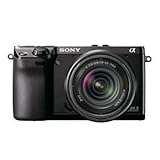As a field-based geoscientist, I take a lot photos of the rocks -- from coastal cliffs to volcanoes -- in the field. I have been using a conventional digital camera over years. This is because it is small and fits in the pocket of my shirt or pants. It is so easy to carry around while walking on the rocky coast, climbing the cliffs or boulders with both hands, rain or shine.

|
SONY デジタル一眼カメラ α NEX-7 ズームレンズキット NEX-7K |
| クリエーター情報なし | |
| ソニー |
I am, however, getting more and more frustrated with a pocket-sized digital camera. The quality of the photos has been indeed getting better, as the resolution and pixel of the digital image has been dramatically improved. On the other hand, it is getting progressively difficult to produce a stunning photo, as everyone is now capable of taking photos or shooting videos, even by using a mobile phone. For this reason, early this year I decided to start learning digital photography from scratch for not only scientific research but also for fun as a hobby (but wanna-be professonal) photographer.
When I worked as a research scientist in the US several years ago, I was using a single-lens reflex digital camera (Nikon DX100) with a telephoto zoom lens. After I moved to Japan seven years ago, however, I stopped using any single-lens reflex, as it is heavy and expensive, and was using a cheap pocket-size digital camera. So I have forgotten how to use a single-lens reflex over years, and I had not learnt photography properly before. When I got the Nikon camera, I was living in Laramie, Wyoming, and no professional help was available locally - I only read the user's manual of the Nikon single-lens-reflex digital camera and learnt how to use it all by myself. Even if I remember how to use it, things must have changed over the past several years with the rapid advance with the digital-photo technology.
Fortunately, here in Tokyo, I have many opportunities to see professional photographers and photo journalists, and their works in a wide range of genres. Many of them are members of the JPS (Japan Photographers' Society) and/or the FCCJ (Foreign Correspondents' Club of Japan). As I am serving as a member of the exhibition committee of the FCCJ and am volunteering to help its monthly photo-exhibition events, I naturally get to know many photographers there from different countries.
So when I told them my plan to start learning digital photography early this year, Albert, one of my photographer friends from the US, recommended I buy Sony's latest model NEX-7 as an excellent starter's kit of single-lens-reflex digital photography. According to Albert, it has a reasonable price, light weight, is easy to carry for my fieldwork, and has decent reviews in trade magazines and on the internet. So I ordered it last February, and I received it in March. However, I was too busy to start learning it, and the camera stayed in the unopened box for too long. Albert and other photographers repeatedly asked me, "Where's your new camera?", sometimes with a disappointed manner (for my laziness). For this reason, last night I brought my Sony camera to the photo exhibition at the FCCJ (see yesterday's blog article).
Before the reception party of the photo exhibition started, I took my very first shot (the above photo) with the camera in the venue. Well, the camera balance was not acceptable (the image is inclined to the left as my posture was so awful), and the camera setting was not adjusted at all then.
Soon my photographer friends started to notice my new Sony camera. None of them had used Sony NEX-7 before. Some said there were too many buttons and too much information displayed on the monitor and the finder. The basic principles were, however, the same irrespecitve the type of single-lens reflex camera.
Each of them gave me different advices (10 photographers use the same camera in 10 different ways). For example, one of them advised me to use ISO400 for exposure to take photos in the venue, whereas others said to use automatic (instead of manual) exposure control. Soon our boss and the chair of the exhibition committee, Bruce Osborne (left man on the above photo) came, and I followed his advice - ISO1000. By picking up my camera, Bruce quickly set up the exposure without seeing a manual -- it was a piece of cake for him. So tonight's free lesson from my photographer friends was the exposure setting of the single-reflex camera. I had taken the photo below with automatic exposure control, just before Bruce manually set up the exposure.
Now, see the photo below. I took it AFTER Bruce set up the exposure to ISO 1,000 (manual control). Can you see the difference?
Wow, even with my unexperienced shaky hands, the photo does look quite different by following a clear and easy advice by Bruce. To confess, I felt a bit doubtul to increase the exposure to ISO 1,000 because other photographers recommended I use ISO400 on spot. Is it the experience that makes this difference? While I was thinking about it with a puzzled face, one of my other photographer friends, Nakamichi-san (the model in the above two photos) advised me:
" It is not a theory. Just use the camera often. Play with it. Practice makes perfect."
I replied, "All right. I'll try."
If Yoda hears my reply, I am sure he would certainly say,
"Try? Do or do not. There is no try."
I wonder why I remembered Yoda's famous quote then? Does Yamamich-san reminded me of Yoda?
Sure, I swear to learn digital photography every day, Mr. Yoda, or Nakamichi-san. Starting this evening, I carry my new digital camera all the time and take photos at many occasions so that I learn how BEST to use the single-lens reflex digital camera.
Shuji
Posted on Wednesday 15 May 2012
 Geo-Science Writer
Geo-Science Writer



